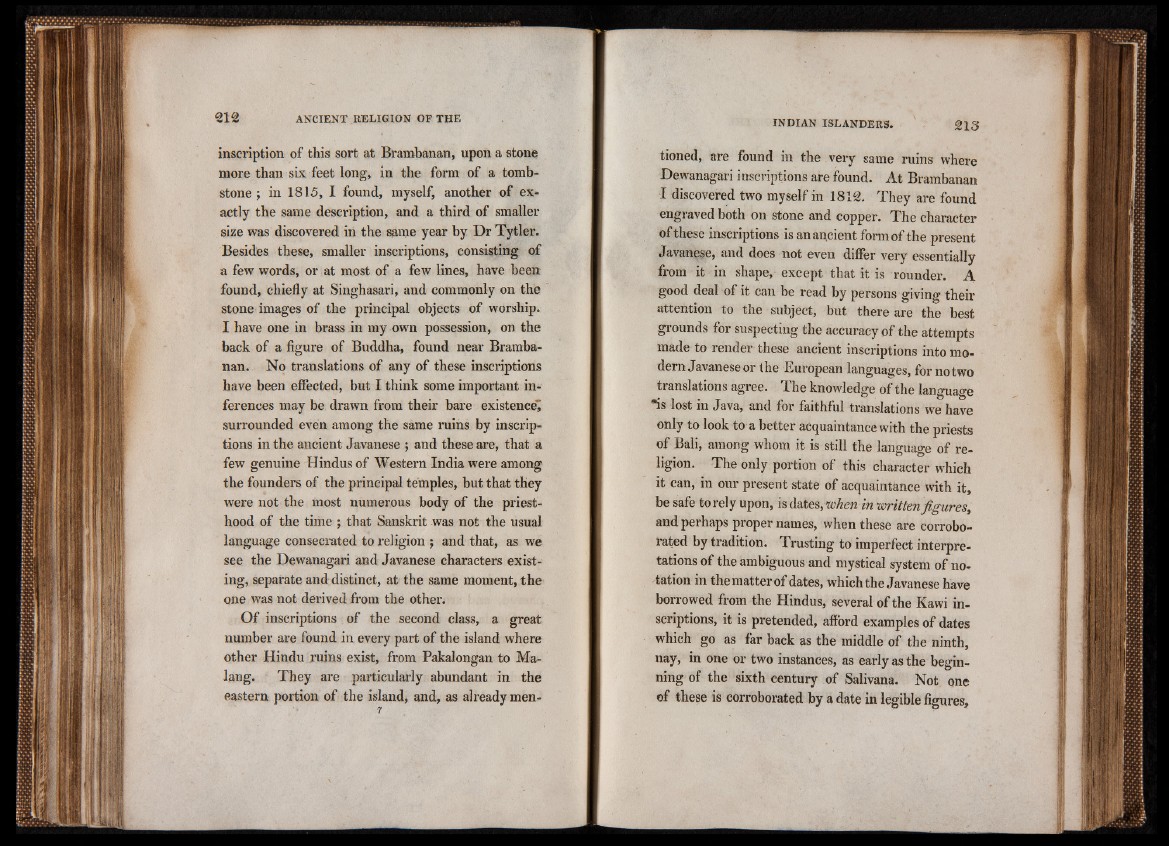
inscription of this sort at Brambanan, upon a stone
more than six feet long, in the form of a tombstone
; in 1815, I found, myself, another of exactly
the same description, and a third of smaller
size was discovered in the same year by Dr Tytler.
Besides these, smaller inscriptions, consisting of
a few words, or at most of a few lines, have been
found, chiefly at Singhasari, and commonly on the
stone images of the principal objects of worship.
I have one in brass in my own possession, on the
back of a figure of Buddha, found near Brambanan.
No translations of any of these inscriptions
have been effected, but I think some important inferences
may be drawn from their bare existence^
surrounded even among the same ruins by inscriptions
in the ancient Javanese ; and these are, that a
few genuine Hindus of Western India were among
the founders of the principal temples, but that they
were not the most numerous body of the priesthood
of the time ; that Sanskrit was not the usual
language consecrated to religion ; and that, as we
see the Dewanagari and Javanese characters existing,
separate and distinct, at the same moment, the
one was not derived from the other.
Of inscriptions of the second class, a great
number are found in every part of the island where
other Hindu ruins exist, from Pakalongan to Malang.
They are particularly abundant in the
eastern portion of the island, and, as already mentioned,
are found in the very same ruins where
Dewanagari inscriptions are found. At Brambanan
I discovered two myself in 1812. They are found
engraved both on stone and copper. The character
of these inscriptions is an ancient form of the present
Javanese, and does not even differ very essentially
from it in shape, except that it is rounder. A
good deal of it can be read by persons giving their
attention to the subject, but there are the best
grounds for suspecting the accuracy of the attempts
made to render these ancient inscriptions into modern
Javanese or the European languages, for notwo
translations agree. The knowledge of the language
•is lost in Java, and for faithful translations we have
only to look to a better acquaintance with the priests
of Bali, among whom it is still the language of religion.
The only portion of this character which
it can, in our present state of acquaintance with it,
be safe to rely upon, is dates ,ivhen in written figures^
and perhaps proper names, when these are corroborated
by tradition. Trusting to imperfect interpretations
of the ambiguous and mystical system of notation
in thematterof dates, which the Javanese have
borrowed from the Hindus, several of the Kawi inscriptions,
it is pretended, afford examples of dates
which go as far back as the middle of the ninth,
nay, in one or two instances, as early as the beginning
of the sixth eentury of Salivana. Not one
of these is corroborated by a date in legible figures,